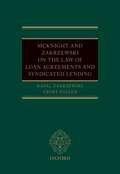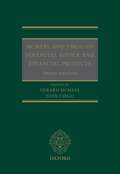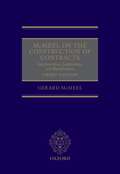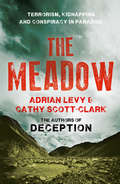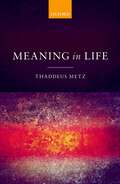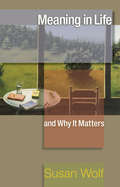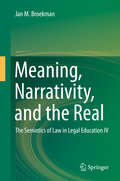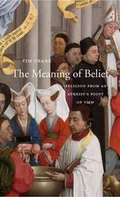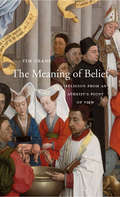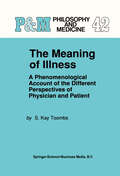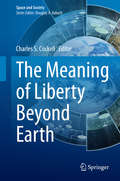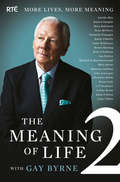- Table View
- List View
McKnight and Zakrzewski on The Law of Loan Agreements and Syndicated Lending
Based on parts of the leading work McKnight, Paterson and Zakrzewski on the Law of International Finance, 2e, this new book is an accessible introduction to loan agreements in English law and practice. The book focusses on loan agreements, syndicates and trading providing the core areas with which newcomers to banking and finance law must familiarize themselves and which often require the most research. The book opens with an overview of English contract law setting out the key concepts and principles relevant to commercial lending transactions. There is a section on loan facility agreements which explains the typical loan agreements, and the relevant law and application to those agreements. In the section on syndicated lending , legal issues arising from the relationship between lenders are analysed and problem areas are tackled. Potential claims, by borrowers against the arrangers of a syndicate and its agent are also analysed, including an explanation of possible protection against such claims. The final part explains the legal and practical issues surrounding the trading in parts of loans on the secondary market. A clear, concise and authoritative work on loan agreements and lending, this book is a useful guide for all working in the field, particularly junior lawyers and postgraduate students.
McKnight, Paterson, & Zakrzewski on the Law of International Finance
by Sarah Paterson; Rafal ZakrzewskiThis acclaimed and comprehensive work analyses the legal issues involved in international finance transactions operating under English law. The second edition thoroughly updates the book to take account of major developments in regulation, practice, and case law since the first edition published in 2008. The most notable development in the intervening period has been the global financial crisis of 2008-9, whose effects have profoundly changed the nature of international finance, and the new edition has been updated by a team of expert editors and contributors to reflect the post-crisis legal framework of international transactions. The new edition covers the many significant changes to Bank Regulation which have occurred since 2008. Major developments in conflicts of laws and cross-border insolvency are addressed, including the consequences of the decision in Rubin v Eurofinance. This edition also takes account of major litigation in the sovereign debt field, significant developments in the loan markets, and recent challenges with the provision of legal opinions, including the increasing need to provide opinions in cross-border transactions. Developments in financing structures in the aftermath of the financial crisis are examined. Significant litigation in the derivatives field (partly as a response to the collapse of Lehman Brothers Holdings Inc.) and amendments proposed by the International Swaps and Derivatives Association are also addressed. There is also coverage of further work on secured transactions following the Law Commission's and the City of London Law Society's Working Party's proposals. Providing detailed transaction-led analysis of all aspects of international finance practice, this work is a must-have reference source for all practitioners and academics working in the field.
McKnight, Paterson, & Zakrzewski on the Law of International Finance
This acclaimed and comprehensive work analyses the legal issues involved in international finance transactions operating under English law. The second edition thoroughly updates the book to take account of major developments in regulation, practice, and case law since the first edition published in 2008. The most notable development in the intervening period has been the global financial crisis of 2008-9, whose effects have profoundly changed the nature of international finance, and the new edition has been updated by a team of expert editors and contributors to reflect the post-crisis legal framework of international transactions. The new edition covers the many significant changes to Bank Regulation which have occurred since 2008. Major developments in conflicts of laws and cross-border insolvency are addressed, including the consequences of the decision in Rubin v Eurofinance. This edition also takes account of major litigation in the sovereign debt field, significant developments in the loan markets, and recent challenges with the provision of legal opinions, including the increasing need to provide opinions in cross-border transactions. Developments in financing structures in the aftermath of the financial crisis are examined. Significant litigation in the derivatives field (partly as a response to the collapse of Lehman Brothers Holdings Inc.) and amendments proposed by the International Swaps and Derivatives Association are also addressed. There is also coverage of further work on secured transactions following the Law Commission's and the City of London Law Society's Working Party's proposals. Providing detailed transaction-led analysis of all aspects of international finance practice, this work is a must-have reference source for all practitioners and academics working in the field.
McMeel and Virgo On Financial Advice and Financial Products
Now in hardback, this comprehensive work covers the legal and regulatory environment in which claims concerning sales of and advice on financial products for individuals and businesses are brought and defended. Fully updated to explain the impact of the twin peaks regulation under the Financial Services Act 2012, the book analyses the role of the Financial Conduct Authority and considers its activities to date. The book covers both statutory claims and traditional 'professional negligence' claims based on contract and tort against financial advisers, brokers, other intermediaries and product providers. Also included in this third edition is a new chapter on consumer credit, considering the transfer of responsibility for the consumer credit regime from the Office of Fair Trading to the Financial Conduct Authority. This is the leading work on professional negligence in the financial services field and is an essential reference tool for all those who advise on bringing or defending such claims.
McMeel on The Construction of Contracts: Interpretation, Implication, and Rectification
by Gerard McMeelNow in its third edition, this authoritative work on the construction of contracts is an invaluable resource for legal practitioners and academics seeking to understand the legal principles involved in contract interpretation as well as the current trends in the neighbouring topics of implied terms and rectification. The third edition continues its principle-by-principle coverage of the main elements of contractual construction with reference to recent case law. Recent major construction of contract cases are discussed, including the UK Supreme Court decisions of Rainy Sky v Kookmin Bank (2011), Arnold v Britton (2015), the Lloyds Bank Bonds case (2016), and Wood v Capita Insurance Services (2017). Guidance is provided on balancing text, context, common sense and commercial purpose. The discussion of the implication of terms reflects the sceptical treatment of Belize Telecom (2009) in the Marks & Spencer case (2015). The issue of rectification addressed in detail in the new edition, reflecting the law's state of flux in this area with cases such as Daventry (2011), Cherry Tree v Landmain (2012) and Tartsinis v Navona (2015). The role of good faith is discussed with reference to Leggatt J in Yam Seng (2014) and the Court of Appeal in MSC Mediterranean Shipping v Cottonex (2016). Agreed damages clauses are revisited in the light of the reining in of the penalty rule in Cavendish v Makdessi (2016). There is consideration of Prime Sight v Lavarello (2013) and the Privy Council's reflections on contractual estoppel. Providing practical guidance on how courts would interpret contractual terms with reference to recent commercial contract litigation, this is the essential reference work for all commercial and corporate lawyers, both litigators and those negotiating and drafting deals.
McMeel on The Construction of Contracts: Interpretation, Implication, and Rectification
by Gerard McMeelNow in its third edition, this authoritative work on the construction of contracts is an invaluable resource for legal practitioners and academics seeking to understand the legal principles involved in contract interpretation as well as the current trends in the neighbouring topics of implied terms and rectification. The third edition continues its principle-by-principle coverage of the main elements of contractual construction with reference to recent case law. Recent major construction of contract cases are discussed, including the UK Supreme Court decisions of Rainy Sky v Kookmin Bank (2011), Arnold v Britton (2015), the Lloyds Bank Bonds case (2016), and Wood v Capita Insurance Services (2017). Guidance is provided on balancing text, context, common sense and commercial purpose. The discussion of the implication of terms reflects the sceptical treatment of Belize Telecom (2009) in the Marks & Spencer case (2015). The issue of rectification addressed in detail in the new edition, reflecting the law's state of flux in this area with cases such as Daventry (2011), Cherry Tree v Landmain (2012) and Tartsinis v Navona (2015). The role of good faith is discussed with reference to Leggatt J in Yam Seng (2014) and the Court of Appeal in MSC Mediterranean Shipping v Cottonex (2016). Agreed damages clauses are revisited in the light of the reining in of the penalty rule in Cavendish v Makdessi (2016). There is consideration of Prime Sight v Lavarello (2013) and the Privy Council's reflections on contractual estoppel. Providing practical guidance on how courts would interpret contractual terms with reference to recent commercial contract litigation, this is the essential reference work for all commercial and corporate lawyers, both litigators and those negotiating and drafting deals.
Mcnae's Essential Law For Journalists: (pdf)
by Siân Harrison Gill PhillipsThe only media law book on the market accredited by the NCTJ, McNae's is the essential guide for journalism students and industry professionals. This indispensable handbook prevails as journalism's foremost authority on media law since its inception in 1954. · Authors' combined expertise in media reporting and teaching offers clear, succinct, and accurate detail on core legal issues · Published in partnership with the National Council for the Training of Journalists and designed to complement accredited syllabi. This text is also recommended for a broad range of media qualifications. · Includes a range of features, such as tips on reporting, need-to-know points, and cross references that explore how different elements of the law interact with each other · Online resources accompany the book, including self-test questions to help students test their understanding, online chapters and additional reading material · Also available as an e-book with functionality, navigation features, and links that offer extra learning support
Mcnae's Essential Law For Journalists (PDF)
by Sian Harrison Mark HannaImportant detail is clearly signposted. The law is explained with clarity in a way that is relevant to journalists. Legal jargon is explained. It is equally relevant to students and working journalists. McNaes gets it right, and in truth I'd be lost without it, and so would my students. ― Karen Nicholson, Senior Lecturer, Nottingham Trent University
Me, You, Us: Essays
by George SherThe essays in Me, You, Us address a range of issues in moral philosophy, political philosophy, and moral psychology, but are unified by their starkly individualistic view of the moral subject. That view regards persons as permanently separated from others by the impenetrability of their subjectivities, and hence as the sole ultimate bearers of both interests and responsibility. Because they are organized around a strong form of moral individualism, the essays challenge recent tendencies to conceptualize normative issues in terms of relationships, collectivities, and social meanings. Of the twelve essays in the collection, the ones on ethics and metaethics deal with questions about the nature of moral standing, the basis of our moral equality, and the justification of the common practice of assigning greater weight to one's own interests than to the interests of others. The essays in political philosophy discuss both the ways in which the wider society does and does not penetrate the individual self and the recent influential attempt to redirect our thinking about justice from the distribution of goods to the relations of domination and subordination that obtain among individuals. The essays in moral psychology criticize some relational accounts of responsibility and blame, and address the complicated relation between what a person knows and what he is responsible and blameworthy for. Three of the collection's essays have not been previously published.
Me, You, Us: Essays
by George SherThe essays in Me, You, Us address a range of issues in moral philosophy, political philosophy, and moral psychology, but are unified by their starkly individualistic view of the moral subject. That view regards persons as permanently separated from others by the impenetrability of their subjectivities, and hence as the sole ultimate bearers of both interests and responsibility. Because they are organized around a strong form of moral individualism, the essays challenge recent tendencies to conceptualize normative issues in terms of relationships, collectivities, and social meanings. Of the twelve essays in the collection, the ones on ethics and metaethics deal with questions about the nature of moral standing, the basis of our moral equality, and the justification of the common practice of assigning greater weight to one's own interests than to the interests of others. The essays in political philosophy discuss both the ways in which the wider society does and does not penetrate the individual self and the recent influential attempt to redirect our thinking about justice from the distribution of goods to the relations of domination and subordination that obtain among individuals. The essays in moral psychology criticize some relational accounts of responsibility and blame, and address the complicated relation between what a person knows and what he is responsible and blameworthy for. Three of the collection's essays have not been previously published.
The Meadow: Kashmir 1995 - Where The Terror Began
by Adrian Levy Cathy Scott-ClarkThe shocking true story of a brutal kidnapping high in the mountains of Kashmir that marked the beginning of modern terrorism. In July 1995, ten backpackers journeyed into the foothills of the Himalayas, trekking to an idyllic campsite known as the Meadow. But their search for tranquillity was savagely interrupted when they were taken hostage by Islamic extremists. Using diaries, letters, classified police reports and interviews with the jihadis themselves, The Meadow traces the escalating tension between kidnappers, victims and police, while examining the high-level conspiracies surrounding the abduction. It tells of the single escape attempt and how – with a brutal beheading – the hostage takers took an irreversible step into the abyss. The shocking true story of the crisis that foreshadowed a new epoch of global terrorism, this is the book that forced Intelligence and government authorities to uncover what really happened in the Meadow.
The Meaning and Purpose of Work: An Interdisciplinary Framework for Considering What Work is For
by Christopher Michaelson Jennifer Tosti-KharasTwo seminal crises of the early 21st century – the 9/11 terrorist attacks and COVID-19 pandemic – have led emerging generations of workers to prioritize the meaning and purpose of work. At the same time, other social and environmental crises are threatening, capitalism is evolving, and technology is advancing. In this book, a philosopher and organizational psychologist who together research meaningful work consider what these forces mean for whether work might give meaning and purpose to our lives or take it away. The authors introduce key concepts – meaning, purpose, and work, among others – and consider how they show up in individuals’ experience of work, what role organizations play in cultivating them, and the responsibilities of markets and states to the individuals and organizations working within them. Each chapter includes questions and prompts for review and reflection for students and workers who read the book. The final chapter concludes by introducing an original “6 P” framework for making sense of the functional and moral purpose of work among individuals, organizations, and systems: to pursue and perform, provide and produce, and price and protect work. Readers will emerge with an understanding of the meaning of meaning as well as a practical appreciation for the role of meaning in their own work, the managerial responsibilities they may have for serving the purpose of the organization they work for, and the societal challenges that make the quest for meaningful work a timely imperative
The Meaning and Purpose of Work: An Interdisciplinary Framework for Considering What Work is For
by Christopher Michaelson Jennifer Tosti-KharasTwo seminal crises of the early 21st century – the 9/11 terrorist attacks and COVID-19 pandemic – have led emerging generations of workers to prioritize the meaning and purpose of work. At the same time, other social and environmental crises are threatening, capitalism is evolving, and technology is advancing. In this book, a philosopher and organizational psychologist who together research meaningful work consider what these forces mean for whether work might give meaning and purpose to our lives or take it away. The authors introduce key concepts – meaning, purpose, and work, among others – and consider how they show up in individuals’ experience of work, what role organizations play in cultivating them, and the responsibilities of markets and states to the individuals and organizations working within them. Each chapter includes questions and prompts for review and reflection for students and workers who read the book. The final chapter concludes by introducing an original “6 P” framework for making sense of the functional and moral purpose of work among individuals, organizations, and systems: to pursue and perform, provide and produce, and price and protect work. Readers will emerge with an understanding of the meaning of meaning as well as a practical appreciation for the role of meaning in their own work, the managerial responsibilities they may have for serving the purpose of the organization they work for, and the societal challenges that make the quest for meaningful work a timely imperative
Meaning in Law: A Theory of Speech
by Charles W. CollierDespite widespread admiration for the First Amendment's protection of speech, this iconic feature of American legal thought has never been adequately theorized. Existing theories of speech proceed on the basis of legal doctrine and judicial decisionmaking, social and political philosophy, or legal and intellectual history. But these are not the disciplines one would most naturally turn to in analyzing speech. Meaning in Law: A Theory of Speech takes a new and different approach. This book develops a general legal theory of speech on the basis of linguistic theory and the philosophy of language. The opening chapters retrace the main conceptual stages in the expression of meaning: from natural meaning, through symbolism, to signification. Later chapters analyze symbolic speech (communication by nonlinguistic means) as the key to developing an intention-based theory of speech. The essential elements of the theory are (1) nonnatural meaning, (2) the signaling of intent, (3) the recognition of intent, and (4) establishing a convention. A final chapter applies these insights to the case law of symbolic speech and resolves some basic confusions in the legal literature. This analysis proceeds by way of an original distinction between actual conduct (in the real world) and the "ideal conduct" described in a statute. The former may be described both as communicative and noncommunicative, while the latter has already been conceptualized as either communicative or noncommunicative. This distinction clears up a major legal quandary: how conduct that counts as communication may nevertheless be regulated or prohibited, without running afoul of the First Amendment's protection of speech.
Meaning in Law: A Theory of Speech
by Charles W. CollierDespite widespread admiration for the First Amendment's protection of speech, this iconic feature of American legal thought has never been adequately theorized. Existing theories of speech proceed on the basis of legal doctrine and judicial decisionmaking, social and political philosophy, or legal and intellectual history. But these are not the disciplines one would most naturally turn to in analyzing speech. Meaning in Law: A Theory of Speech takes a new and different approach. This book develops a general legal theory of speech on the basis of linguistic theory and the philosophy of language. The opening chapters retrace the main conceptual stages in the expression of meaning: from natural meaning, through symbolism, to signification. Later chapters analyze symbolic speech (communication by nonlinguistic means) as the key to developing an intention-based theory of speech. The essential elements of the theory are (1) nonnatural meaning, (2) the signaling of intent, (3) the recognition of intent, and (4) establishing a convention. A final chapter applies these insights to the case law of symbolic speech and resolves some basic confusions in the legal literature. This analysis proceeds by way of an original distinction between actual conduct (in the real world) and the "ideal conduct" described in a statute. The former may be described both as communicative and noncommunicative, while the latter has already been conceptualized as either communicative or noncommunicative. This distinction clears up a major legal quandary: how conduct that counts as communication may nevertheless be regulated or prohibited, without running afoul of the First Amendment's protection of speech.
Meaning in Life
by Thaddeus MetzWhat makes a person's life meaningful? Thaddeus Metz offers a new answer to an ancient question which has recently returned to the philosophical agenda. He proceeds by examining what, if anything, all the conditions that make a life meaningful have in common. The outcome of this process is a philosophical theory of meaning in life. He starts by evaluating existing theories in terms of the classic triad of the good, the true, and the beautiful. He considers whether meaning in life might be about such principles as fulfilling God's purpose, obtaining reward in an afterlife for having been virtuous, being attracted to what merits attraction, leaving the world a better place, connecting to organic unity, or transcending oneself by connecting to what is extensive. He argues that no extant principle satisfactorily accounts for the three-fold significance of morality, enquiry, and creativity, and that the most promising theory is a fresh one according to which meaning in life is a matter of intelligence contoured toward fundamental conditions of human existence.
Meaning in Life and Why It Matters
by Susan Wolf John Koethe Robert M. Adams Nomy Arpaly Jonathan Haidt Stephen MacedoMost people, including philosophers, tend to classify human motives as falling into one of two categories: the egoistic or the altruistic, the self-interested or the moral. According to Susan Wolf, however, much of what motivates us does not comfortably fit into this scheme. Often we act neither for our own sake nor out of duty or an impersonal concern for the world. Rather, we act out of love for objects that we rightly perceive as worthy of love--and it is these actions that give meaning to our lives. Wolf makes a compelling case that, along with happiness and morality, this kind of meaningfulness constitutes a distinctive dimension of a good life. Written in a lively and engaging style, and full of provocative examples, Meaning in Life and Why It Matters is a profound and original reflection on a subject of permanent human concern.
Meaning in Life and Why It Matters
by Susan Wolf John Koethe Robert M. Adams Nomy Arpaly Jonathan Haidt Stephen MacedoMost people, including philosophers, tend to classify human motives as falling into one of two categories: the egoistic or the altruistic, the self-interested or the moral. According to Susan Wolf, however, much of what motivates us does not comfortably fit into this scheme. Often we act neither for our own sake nor out of duty or an impersonal concern for the world. Rather, we act out of love for objects that we rightly perceive as worthy of love--and it is these actions that give meaning to our lives. Wolf makes a compelling case that, along with happiness and morality, this kind of meaningfulness constitutes a distinctive dimension of a good life. Written in a lively and engaging style, and full of provocative examples, Meaning in Life and Why It Matters is a profound and original reflection on a subject of permanent human concern.
Meaning, Narrativity, and the Real: The Semiotics of Law in Legal Education IV
by Jan M. BroekmanThis book examines the concept of meaning and our general understanding of reality in a legal and philosophical context. Starting from the premise that meaning is a matter of linguistic and other forms of articulation, it considers the inherent philosophical consequences. Part I presents Klages’, Derrida’s, Von Hofmannsthal’s and Wittgenstein’s explorations of silence as a source of articulation and meaning. Debates about 20th century psychologism gave the attitude concept a pivotal role; it illustrates the importance of the discovery that a word is globally qualified as ‘the basic unit of language’. This is mirrored in the fact that we understand reality as a matter of particles and thus interpret the real as a component of an all-embracing ‘particle story’. Each chapter of the book focuses on an aspect of legal semiotics related to the chapter’s theme: for instance on the meaning of a Judge’s ‘Saying for Law’, on law students training in varying attitudes or on the ties between law and language. Part II of the book illustrates our general understanding of reality as a matter of particles and partitioning, and examines texts that prove that particle thinking is basic for our meaning concept. It shows that physics, quantum theory, holism, and modern brain research focusing on human linguistic capabilities, confirm their ties to the particle story. In contrast, the book concludes that partitions and particles are neither a fact in the history of the cosmos nor a determinant of knowledge and the sciences, and that meaning is a process: a constellation rather than a fixation. This is manifest once one understands meaning as the result of continuously changing attitudes, which create our narratives on cosmos and creation. The book proposes a new key for meaning: a linguistic occurrence anchored in dimensions of human narrativity.
The Meaning of Belief: Religion from an Atheist’s Point of View
by Tim CraneCurrent debate about religion seems to be going nowhere. Atheists persist with their arguments, many plausible and some unanswerable, but they make no impact on believers. Defenders of religion find atheists equally unwilling to cede ground. Noting that religion is not what atheists think it is, Tim Crane offers a way out of this stalemate.
The Meaning of Belief: Religion from an Atheist’s Point of View
by Tim CraneCurrent debate about religion seems to be going nowhere. Atheists persist with their arguments, many plausible and some unanswerable, but they make no impact on believers. Defenders of religion find atheists equally unwilling to cede ground. Noting that religion is not what atheists think it is, Tim Crane offers a way out of this stalemate.
The Meaning of Evil
by James SiasIn this book, James Sias investigates the psychologies of those who have acted in ways widely regarded as evil, and uses this psychological data as a basis for developing his own theory of evil. Sometimes, he claims, an action is so horrific and despicable that a term like “wrong” seems to fall short of capturing its moral status. Likewise, occasionally a person’s character is corrupt in such a way that ordinary trait terms like “selfish” or “insensitive,” or more general labels like “bad” or “immoral,” seem inadequate. In such cases, we often resort to calling the person or action “evil.” But what does this term mean? What is it that makes a person or action morally evil? Taking a cue from Hannah Arendt, Sias argues that this sort of evil is essentially a matter of regarding others as “morally superfluous.” In other words, evil is a matter of utter moral disregard. In the course of developing and defending this view, Sias also describes and critiques a number of prominent theories of evil proposed by philosophers in recent years.
The Meaning of Illness: A Phenomenological Account of the Different Perspectives of Physician and Patient (Philosophy and Medicine #42)
by S. Kay ToombsThis work provides a phenomenological account of the experience of illness and the manner in which meaning is constituted by the patient and the physician. The author provides a detailed account of the way in which illness and body are apprehended differently by doctor and patient. This title has been awarded the first Edwin Goodwin Ballard Prize in Phenomenology.
The Meaning of Liberty Beyond Earth (Space and Society)
by Charles S. CockellThe purpose of this book is to initiate a new discussion on liberty focusing on the infinite realms of space. The discussion of the nature of liberty and what it means for a human to be free has occupied the minds of thinkers since the Enlightenment. However, without exception, every one of these discussions has focused on the character of liberty on the Earth. The emergence of human space exploration programs in the last 40-50 years raise a fundamental and new question: what will be the future of liberty in space? This book takes the discussion of liberty into the extraterrestrial environment. In this book, new questions will be addressed such as: Can a person be free when the oxygen the individual breathes is the result of a manufacturing process controlled by someone else? Will the interdependence required to survive in the extremities of the extraterrestrial environment destroy individualism? What are the obligations of the individual to the extraterrestrial state? How can we talk of extraterrestrial liberty when everyone is dependent on survival systems?
The Meaning of Life 2 – More Lives, More Meaning with Gay Byrne: 20 Famous People Reflect on Life’s Big Questions
by Gay ByrneMore big questions – and more interesting answers – from Gay Byrne’s hugely popular RTÉ TV showWe all look for meaning in our lives and here twenty well-known public figures share what gives their lives meaning, prompting us to ponder the question ourselves and perhaps even find some answers.Following last year’s bestselling The Meaning of Life, Gay Byrne is back with more insightful discussions on the big themes that bind us all: childhood, love, faith, disbelief, morality, religion, grief.Based on his popular and long-running RTÉ TV show, The Meaning of Life 2 explores life’s big questions with an array of fascinating public figures, among them Ronan Keating, Micheál Ó Muircheartaigh, Ian Paisley and Imelda May.With Peter McVerry he ponders whether life is shaped by accidents or by the way people respond to accidents. Mary Robinson reveals the beliefs and values that fuel her formidable moral engine. Eamon Dunphy’s early experiences led him to believe that ‘everyone is magnificent in their own way’, and Edna O’Brien discusses her struggles with the Catholic Church after the infamous banning of The Country Girls.’There are many pearls of wisdom to be harvested from the human oysters featured here who share with me the beliefs, values, thoughts and experiences that have shaped, or been shaped by, their lives.’Gay ByrneThe Meaning of Life 2: Table of ContentsPreface by Gay ByrneImelda MayPeter McVerryMary RobinsonBrian CodyIan PaisleyJ. P. DonleavyEmily O’ReillyJohn LonerganRonan KeatingMaureen GaffneySean O’SullivanChristina NobleMicheál Ó MuircheartaighFionnula FlanaganColm TóibínMary ByrneColm WilkinsonCeline ByrneEdna O’BrienEamon DunphyFor each book sold, a donation will be made to The Peter McVerry Trust and The Christina Noble Children’s Foundation.
